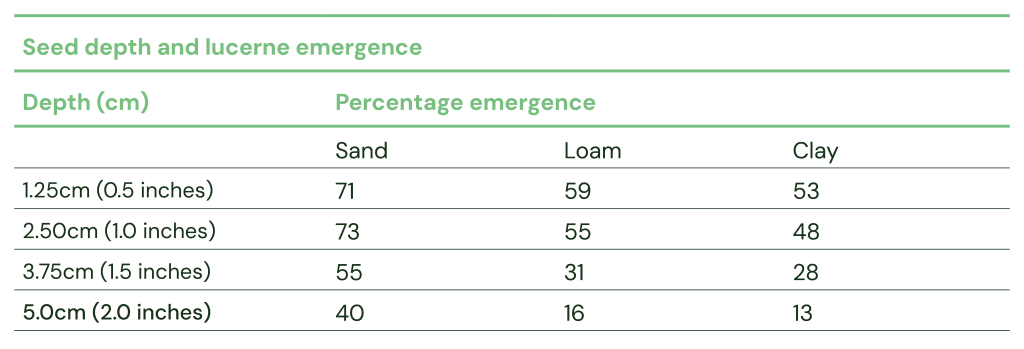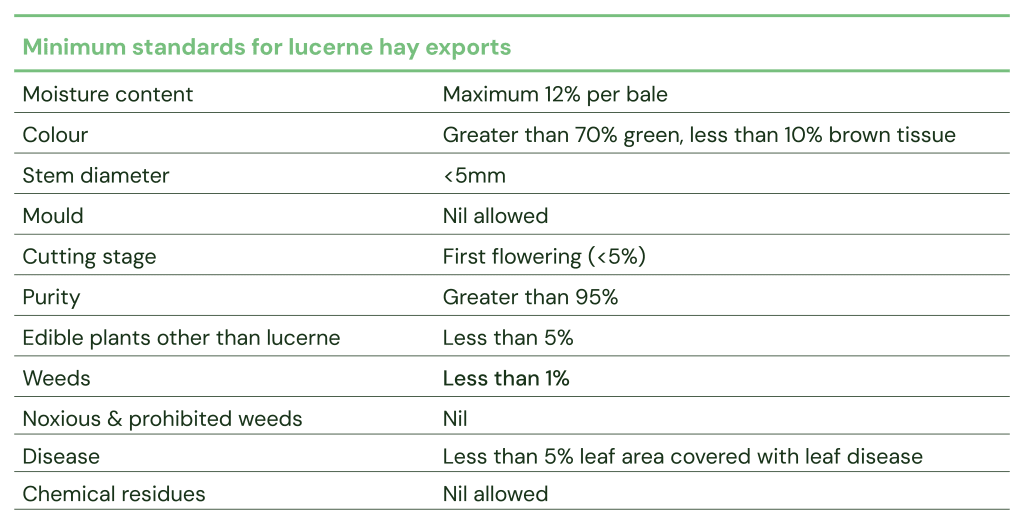Lucerne Advisor Series: Getting lucerne right from the start
August 18, 2025 All Regions
With the right setup, lucerne can deliver high-quality feed, strong year-round production, and improved soil health
From soil pH and drainage to variety choice and sowing depth, getting the basics right makes all the difference to stand longevity, productivity and resilience.
Why grow lucerne?
Lucerne is a long-term pasture investment that pays off with:
- High-quality feed — protein-rich, palatable, and digestible
- Resilience — deep roots chase moisture and recover quickly
- Soil benefits — improves nitrogen and supports soil structure
With the right setup, lucerne works hard across grazing, hay, silage and rotation roles.
Choosing the right paddock
For successful establishment, aim for:
- Soil pH (CaCl₂) between 5.0–7.5
- Lucerne is highly sensitive to waterlogging — choose well-drained paddocks to avoid crown disease and plant loss
- If residual herbicides may be present, speak to your agronomist about risk before sowing
Industry best practice suggests pot testing or delaying planting if residual chemistry is a concern.
Preparing your seedbed
Lucerne seed is small and sensitive. A well-prepared seedbed:
- Is firm, level and lightly cloddy
- Has good soil moisture to a depth of 20cm
- Is weed-free before sowing, use knockdowns and pre-emergents like Trifluralin
Cover crops can be used, but reduce their seeding rate by 50% and sow in alternate rows.
Drill vs broadcast — what actually works?
Lucerne performs best when it’s drilled into a prepared, level, and weed-free seedbed.
Broadcast sowing can work in certain oversowing or renovation scenarios, but generally:
- Drilling gives better seed placement and moisture contact
- Broadcasting carries more risk of shallow, uneven emergence
If broadcasting is necessary, always roll post-sowing to improve seed-soil contact.
Picking the right variety
Choosing the right variety means matching dormancy, grazing pressure, soil type and production goals.
- For rapid establishment and year-round forage, L97 is a highly winter active option ideal for silage and short-term rotations.
- For grazing pressure and persistence, GTL60® is a true-to-type grazing tolerant variety, bred specifically to handle Australian grazing systems
- For a wide range of soil types and enterprises, L56® is the ultimate dual-purpose lucerne variety for Australian conditions
Each variety in the AlfaGen range offers something different, from salt tolerance to flexible cutting intervals. If you’re unsure, ask our team to help match the right option to your system.
Use treated seed
AlfaGen Seeds lucerne comes treated with Goldstrike XLR8®, which includes:
- Protective fungicides for disease resistance
- Rhizobia inoculant for early nitrogen fixation
- Moisture-activated coating for consistent germination
- Insecticide designed to give seedlings the best possible start
It’s a small detail that makes a big difference during establishment.
Getting seeding right
Sow at 5–15mm depth — no deeper — and aim for:
- 4-10kg/ha in dryland conditions
- 18-25kg/ha under irrigation or high rainfall
Target plant densities:
- Dryland: 20-90 plants/m²
- Irrigated: 130+ plants/m²

Check stands within the first 8 weeks. A patchy or weak establishment now will cost yield for years — it’s better to oversow early than struggle through thin paddocks.
Quality starts in the paddock
Lucerne hay isn’t just about what happens at cutting — it starts with how you set up your crop. Poor drainage, uneven plant density or weed blowouts early on can directly affect your ability to hit feed quality targets later.
Whether you’re feeding on-farm or chasing premium hay markets, these quality standards give you a benchmark to work towards from day one.
Minimum standards for lucerne hay exports
This table highlights why clean establishment, strong variety choice and good early management matter — mould, weeds, stem thickness and even tissue colour all come back to decisions made before sowing.

Ready for next steps?
Getting lucerne right from the start sets you up for years of quality feed and strong regrowth. With the right paddock preparation and variety selection, lucerne can be a highly rewarding crop that keeps delivering season after season.
You’ve nailed the groundwork — literally. If you’re preparing to sow lucerne, here’s what to explore next in the Lucerne Advisor Series:
Need help choosing the right variety?
Explore the AlfaGen lucerne range or talk to your local Territory Manager.